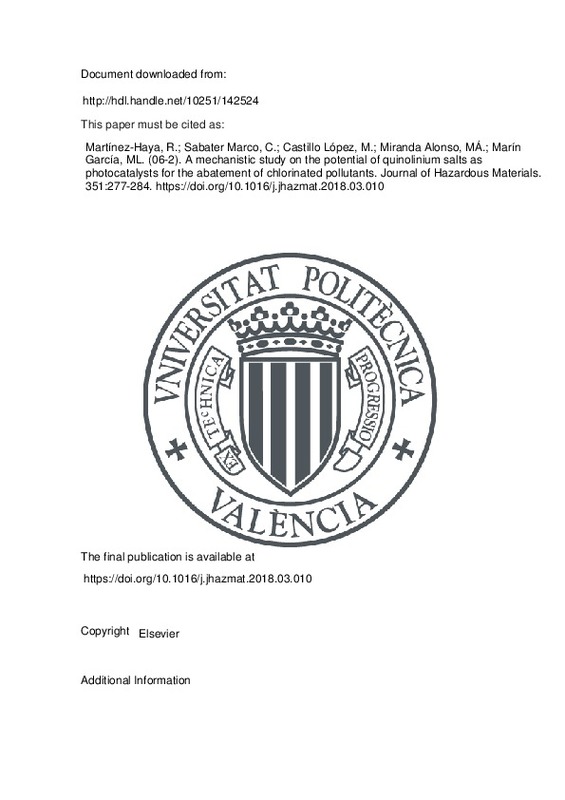JavaScript is disabled for your browser. Some features of this site may not work without it.
Buscar en RiuNet
Listar
Mi cuenta
Estadísticas
Ayuda RiuNet
Admin. UPV
A mechanistic study on the potential of quinolinium salts as photocatalysts for the abatement of chlorinated pollutants
Mostrar el registro sencillo del ítem
Ficheros en el ítem
| dc.contributor.author | Martínez-Haya, Rebeca
|
es_ES |
| dc.contributor.author | Sabater Marco, Consuelo
|
es_ES |
| dc.contributor.author | Castillo López, María-Ángeles
|
es_ES |
| dc.contributor.author | Miranda Alonso, Miguel Ángel
|
es_ES |
| dc.contributor.author | Marín García, Mª Luisa
|
es_ES |
| dc.date.accessioned | 2020-05-06T07:18:31Z | |
| dc.date.available | 2020-05-06T07:18:31Z | |
| dc.date.issued | 2018-06 | es_ES |
| dc.identifier.issn | 0304-3894 | es_ES |
| dc.identifier.uri | http://hdl.handle.net/10251/142524 | |
| dc.description.abstract | [EN] Photocatalytic degradation of three highly chlorinated contaminants, namely 2,4,6-trichlorophenol (TCP), 2,4,6-trichloroanisole (TCA) and 5-chloro-2-(2,4-dichlorophenoxy)phenol (triclosan, TCS) has been investigated in the presence of N-methylquinolinium tetrafluoroborate (NMQ(+)), a photocatalyst able to act via Type I or Type II mechanism. Photodegradation of contaminants under aerobic conditions was achieved within hours; and it was accompanied by mineralization, as demonstrated by trapping of the evolved carbon dioxide as barium carbonate. Moreover, a high degree of detoxification, based on % inmobilization of daphnids (Daphnia magna bioassay), was reached after 70 h of irradiation. Quenching of the NMQ(+) fluorescence by the pollutants was evidenced by a decrease in the emission intensity and lifetime. Detection of the reduced NMQ. by laser flash photolysis in the presence of the pollutants provided an unambigous evidence of the electron transfer process. Quenching of singlet oxygen by the contaminants showed the typical singlet oxygen quenching constants (10(5)-10(6) M-1 s(-1)). Evaluation of the relative contribution of both pathways (Type I vs Type II) point to the photodegradation occurring via a Type I mechanism, being the contribution of Type II mechanism negligible at any concentration range. | es_ES |
| dc.description.sponsorship | Financial support from Spanish Government (Grant SEV-2016.0683 and CTQ2015-69832-C4) and generous contribution from Generalitat Valenciana (Prometeo Program) are gratefully acknowledged. We also thank support from VLC/Campus. R Martinez-Haya thanks financial support from Spanish Government (Grant SEV-2012-0267). | es_ES |
| dc.language | Inglés | es_ES |
| dc.publisher | Elsevier | es_ES |
| dc.relation.ispartof | Journal of Hazardous Materials | es_ES |
| dc.rights | Reconocimiento - No comercial - Sin obra derivada (by-nc-nd) | es_ES |
| dc.subject | Electron transfer | es_ES |
| dc.subject | Laser flash photolysis | es_ES |
| dc.subject | Singlet excited state | es_ES |
| dc.subject | Singlet oxygen | es_ES |
| dc.subject | Time-resolved fluorescence | es_ES |
| dc.subject.classification | BIOQUIMICA Y BIOLOGIA MOLECULAR | es_ES |
| dc.subject.classification | MICROBIOLOGIA | es_ES |
| dc.subject.classification | QUIMICA ORGANICA | es_ES |
| dc.title | A mechanistic study on the potential of quinolinium salts as photocatalysts for the abatement of chlorinated pollutants | es_ES |
| dc.type | Artículo | es_ES |
| dc.identifier.doi | 10.1016/j.jhazmat.2018.03.010 | es_ES |
| dc.relation.projectID | info:eu-repo/grantAgreement/MINECO//SEV-2012-0267/ | es_ES |
| dc.relation.projectID | info:eu-repo/grantAgreement/MINECO//SEV-2016-0683/ | es_ES |
| dc.relation.projectID | info:eu-repo/grantAgreement/MINECO//CTQ2015-69832-C4-4-R/ES/TECNOLOGIAS EFICIENTES PARA LA ELIMINACION DE CONTAMINANTES DE PREOCUPACION EMERGENTE, CONTENIDOS EN DIRECTIVA 2013%2F39%2FCE O DE RIESGO SIGNIFICATIVO SEGUN DIRECTIVA 2008%2F105%2FCE/ | es_ES |
| dc.rights.accessRights | Abierto | es_ES |
| dc.contributor.affiliation | Universitat Politècnica de València. Departamento de Química - Departament de Química | es_ES |
| dc.contributor.affiliation | Universitat Politècnica de València. Departamento de Biotecnología - Departament de Biotecnologia | es_ES |
| dc.description.bibliographicCitation | Martínez-Haya, R.; Sabater Marco, C.; Castillo López, M.; Miranda Alonso, MÁ.; Marín García, ML. (2018). A mechanistic study on the potential of quinolinium salts as photocatalysts for the abatement of chlorinated pollutants. Journal of Hazardous Materials. 351:277-284. https://doi.org/10.1016/j.jhazmat.2018.03.010 | es_ES |
| dc.description.accrualMethod | S | es_ES |
| dc.relation.publisherversion | https://doi.org/10.1016/j.jhazmat.2018.03.010 | es_ES |
| dc.description.upvformatpinicio | 277 | es_ES |
| dc.description.upvformatpfin | 284 | es_ES |
| dc.type.version | info:eu-repo/semantics/publishedVersion | es_ES |
| dc.description.volume | 351 | es_ES |
| dc.identifier.pmid | 29554524 | es_ES |
| dc.relation.pasarela | S\369134 | es_ES |
| dc.contributor.funder | Generalitat Valenciana | es_ES |
| dc.contributor.funder | Universitat Politècnica de València | es_ES |
| dc.contributor.funder | Ministerio de Economía y Competitividad | es_ES |







![[Cerrado]](/themes/UPV/images/candado.png)

